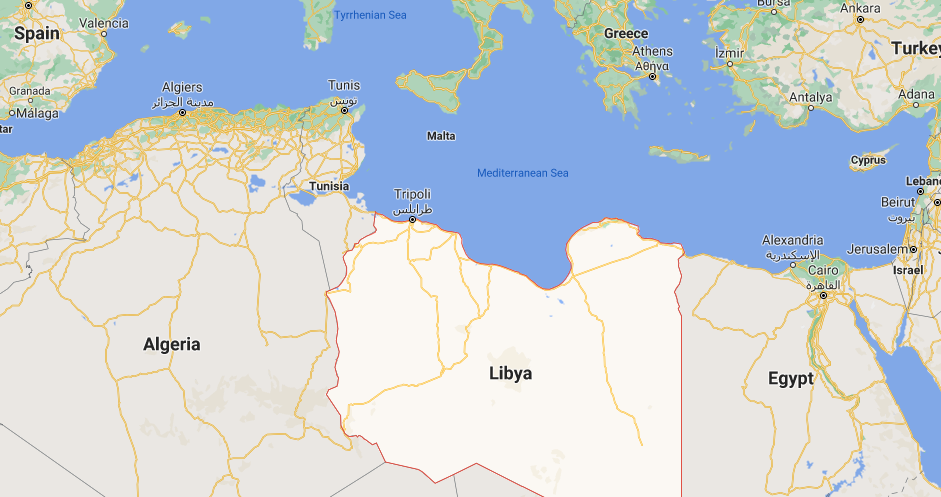2. Libya (country in North Africa)
On the Mediterranean Sea between Algeria to the left and Egypt to the right. Capital is Tripoli.
The dishes we made:
Shakshuka-Egg Poached in Tomato Sauce. Khbeiza bil Tonn-Tuna-Harissa-Olive Stuffed Bread. Mafrum (which is a Libyan dish made with ground beef sandwiched in assorted vegetables. The most popular are potatoes, eggplant and cauliflower, which are dipped in flour and egg, fried in oil and then cooked in a red sauce.
Condiment: Pilpelchuma (Filfel Chuma-a Libyan Jewish red Chilli Paste from Tripoli).
Shakshuka-Egg Poached in Tomato Sauce VERY Good!
Pronounced Shahk-SHOO-kah!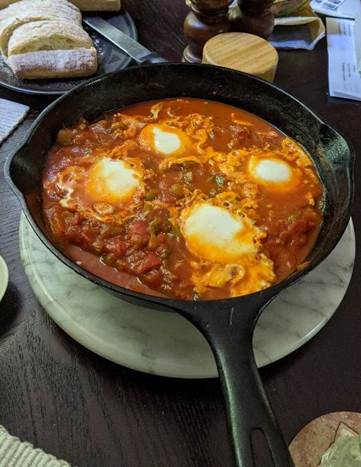
This dish is made with eggs that are gently poached in a simmering mixture of tomatoes, bell peppers, onions, garlic and spices.
Serve it for breakfast, brunch, lunch, brinner or dinner!
Olive Oil
1 large Onion, chopped
1 Green Bell Peppers, chopped
2 Garlic cloves, chopped
1 tsp ground Coriander
1 tsp Sweet Paprika
1/2 tsp ground cumin
Pinch Red Pepper Flakes (optional)
Salt and Pepper
6 Tomatoes, chopped (~6 cups chopped tomatoes)
1/2 cup Tomato Sauce
4-6 large eggs, depending on number of people
1/4 cup chopped fresh Parsley leaves
1/4 cup chopped fresh Mint leaves
Heat olive oil in a large cast iron skillet.
Add the onions, green peppers, garlic, spices, pinch salt and pepper. Cook, stirring occasionally, until the vegetables have softened, ~5 min.
Add the tomatoes and tomato sauce. Cover and let simmer for ~15 min.
Uncover and cook a bit longer to allow the mixture to reduce and thicken. Taste and adjust the seasoning.
Using a wooden spoon, make 6 indentations, or “wells,” in the tomato mixture (make sure the indentations are spaced out). Gently crack an egg into each indention.
Reduce the heat, cover the skillet, and cook on low until the egg whites are set.
Uncover and add the fresh parsley, mint, black pepper or crushed red pepper, if you like.
Serve with warm pita, challah bread, or your choice of crusty bread.
Tuna, Harissa and Olive Stuffed Bread: Khbeiza bil Tonn فطاير تونة و هريسة
Khbeiza bil tonn is a small individually stuffed Libyan bread often served to guests with afternoon tea.
The dough consists of flour, milk, butter, and yeast and shaped into small loaves, crescents, or balls.
Often filled with dried mint, white cheese and olives, however, the most popular stuffing is made with tuna and harissa. It is usually decorated with cumin or sesame seeds before baking.
Makes 32 pieces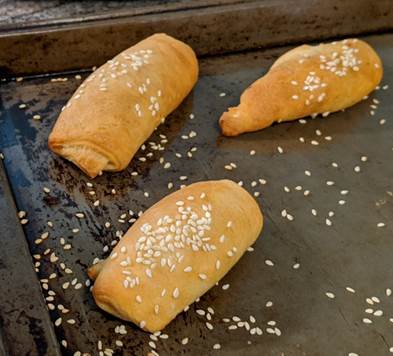
2 Tbsp dry yeast
~5 Tbsp (75 grams) melted Butter
1 1/2 cups Milk
3 1/2 cups Flour (210 grams)
1 Tbsp Salt
Filling
400g Tuna (2 cans), well drained
Harissa (homemade or commercial) to taste
1 cup olives (pitted and chopped)
Decoration
1 egg, beaten
Sesame seeds or Habet Baraka (Black cumin seeds/Nigella seeds)
Crumble the yeast into a little warmed milk and set aside to activate yeast, melt the butter and mix with the rest of the milk then leave to reach room temperature.
Place the flour and salt in your mixing bowl, add the milk and yeast mixture.
Pour in the butter and milk.
Knead to a dough with a soft and smooth consistency, cover and leave to rise (around half an hour).
Meanwhile drain the tuna, mash it with a fork and add harissa to taste. 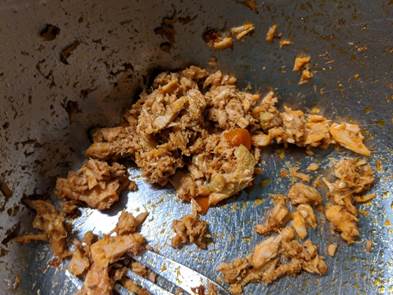
Pit and chop the olives and combine with the tuna and harissa.
Divide the dough into four equal balls.
Roll each ball into a circle, then cut into 8 triangles.
Place a tablespoon of filling at the base of each triangle, rolling into a crescent shape as below.
Place the Khbeiza on a tray lined with baking paper, brush them with the beaten egg and sprinkle a pinch of Habet albaraka on each then leave to rest in a warm place for about 30 minutes.
Bake in the middle of the oven at 435°F (225°C) until golden, usually about 15 minutes.
Best served hot, this stuffed bread is also delicious at room temperature.
Harissa VERY Good!
7 Dried New Mexico Chiles or Guajillo Chiles or a combination of De Arbol or Chipotle Chiles
6 oz jarred Roasted Red Peppers drained rinsed 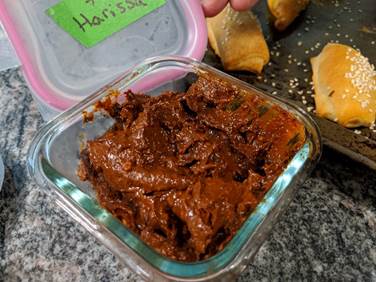
2 tbsp Tomato Paste
4 large Garlic cloves peeled
1 tsp Caraway Seeds toasted and ground
2 tsp ground Coriander
2 tsp ground Cumin
1 tsp Smoked Paprika
Salt
Juice of 1 large Lemon (or ~2 tbsp fresh lemon juice)
2 tbsp quality extra virgin Olive Oil or more if needed
Soak and prepare the dried chiles. Place the dried chiles in a bowl and cover with hot water. Set aside for 30 minutes until the chiles are tender and re-hydrated. Drain the chiles and remove the stems and seeds.
Combine chiles with the remaining ingredients. Transfer the chiles to food processor. Add the tomato paste, roasted red peppers, garlic, ground caraway seeds, coriander, cumin, smoked paprika, and a large pinch of kosher salt. Add fresh lemon juice.
Make the harissa paste. Run the food processor, and while it’s running, drizzle the extra virgin olive oil from the top opening. Stop the processor to scrape down the sides and run again until you reach the desired paste-like texture. Taste and adjust seasonings to your liking (remember that harissa paste will deepen in flavor as it sits in the fridge over the next day or two).
Store. Transfer the harissa paste to a clean mason jar. Cover with a very thin layer of extra virgin olive oil, then cover the jar with its lid tightly and refrigerate.
Mafrum (Libyan dish - Beef stuffed Veggies in Tomato-based Sauce) VERY Good!
2 Medium Potatoes, peeled
1 Eggplant
4-5 Cauliflower Florets
For the stuffing Mixture:
0.6 lbs ground Beef (300g)
0.3 lbs minced Lamb (150g)
1 medium onion, finely chopped or grated
100g breadcrumbs
1 cup mix of chopped coriander, parsley, mint
2 large garlic cloves
1 Tbsp Baharat spice mix
1 Tbsp Ground cumin
1 Egg, beaten
1/2 Tsp salt
1/2 Tsp pepper
To coat:
1 cup all purpose flour
1/4 tsp salt
3 eggs, beaten
2 tbsp tomato puree
vegetable oil for frying
For the sauce:
3 Onions, chopped
3 big garlic cloves, chopped
4 Tbsp tomato puree
1 Tbsp Baharat spice mix
2 Tbsp smoked paprika spice
1/2 Tbsp Ground cumin
1/2 tsp spicy ground chilli (optional)
Pinch of sugar
1 tsp salt
1/2 tsp pepper
2-3 cups of water
Slice potatoes and eggplant into ~1 inch thick slices. Create a cut in the middle of each slice like you’d open a pita, but cut only 3/4 through so the piece remains intact.
Cover potatoes in cold water and mix in 1 Tbsp of salt & let soak for 30 minutes.
Sprinkle eggplant with salt and let rest on a paper towel for 30 minutes. Dab off water with paper towel.
Break palm size florets off your cauliflower, cut out small v-wedge in top of floret, set aside.
Mix together ground lamb, ground beef, eggs, coriander, parsley, mint, onion, breadcrumbs, garlic, cumin, baharat spice mix, salt and pepper
Once your vegetables are ready, drain the water out of the potatoes and let them dry for a few minutes. Wipe the moisture and salt from the eggplants.
Make a small ball from the meat mixture and stuff it inside each piece of vegetable, be gentle, and once it’s in there, press the sides of the veggies to sandwich it up tightly but without pressing the mixture out.
Take a large pot or skillet skillet that has a lid (I use Le Creuset) and heat a good amount of oil for suateeing/frying in it on medium heat.
Prepare a plate with flour & salt and another bowl with the eggs & a tomato puree, whisk well to combine.
Preheat the oven to 300 degrees F.
When the oil is hot, dip each piece of vegetable in the flour, make sure everything is covered and tap it lightly to remove access flour. Then dip the piece in the egg mixture on all sides, and straight into the oil.
Fry the pieces slowly, a few minutes on each side. Let them caramelize and bit, if the heat is too high turn it down. Flip them over to the other side and let them get this nice golden color.
Remove them gently using a slotted spoon or two forks, and place them on a wire rack with paper towels underneath to catch the excess oil
Chop 3 small onions and sauté them in the same skillet you used to fry your veggies, add olive oil if needed.
After the onions are nice and transparent, add the garlic, tomato puree, Baharat spice mix, smoked paprika spice (or regular), a bit of cumin, pinch of sugar, salt and pepper and if you’d like it with a bit of a spicy kick, add chili spice in there too. Sauté for 2-3 minutes until fragrant.
Add 2 cups of water and stir it well together. Arrange the vegetables in tightly together, the water should almost reach the top of the vegetables, about 3/4 through. Add the rest of the water if needed.
Bring to a gentle simmer, cover and place in the oven for 1.5-2 hours, until the potatoes are soft and most of the fluids are absorbed. You can also leave it covered on the stove on very low heat for 2 hours. Check occasionally and add some water if needed.
Traditionally served with couscous.
Pilpelchuma (Filfel Chuma-a Lybian Jewish Red Chilli Paste from Tripoli):
This is from the Libyan Jews of Tripoli. Spicy, garlicky and tangy, it can be used a condiment and ingredient.
The history of Libyan Jews can be traced back to around 300 BCE, when the Sahara Desert, which now covers 90% of Libya, was lush and green. It was a thriving, cosmopolitan community (especially under Italian rule in modern Libya). Sadly though, not a single Jew is to be found in the Libya of today.
15 dried Red Chillies any sort, heat level is up to you
1/2 Tbsp whole Caraway Seeds
1/2 Tbsp whole Cumin Seeds
15 medium-sized Garlic cloves
1 Tbsp Sweet Paprika, non smoky
80 ml (1/3 cup) light Olive Oil, plus more olive oil any kind for covering before storage
1/2 tsp Salt
1/2 tsp White Sugar
3 Tbsp fresh Lemon Juice
Soak dried chillies in bowl with boiling water for at least 15 min.
Dry roast cumin & caraway seeds in pan for ~2 min. Grind to fine powder.
Drain chillies and add to food processor along with garlic and half the olive oil in and process for a minute.
Now add everything else in and process to a fairly fine paste.
Put in a mason jar and add a thin layer of olive oil and store in the fridge. It will last for 2 weeks easily. Keep topping it with a layer of oil each time you take some out, and it will last for 3-4 weeks. The oil is there to prevent bacteria from settling and your paste from getting moldy.
